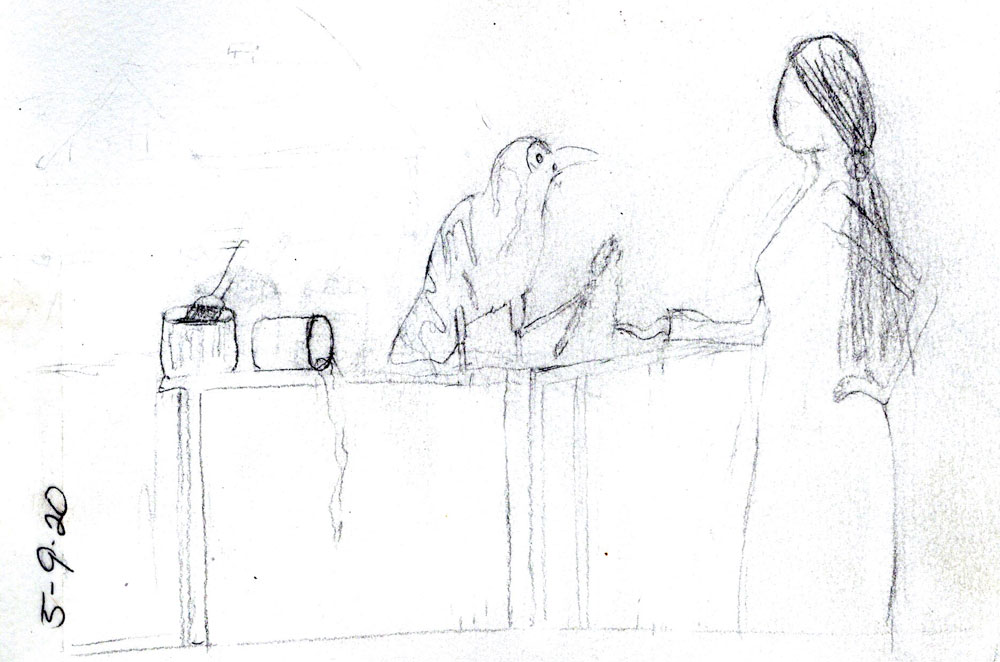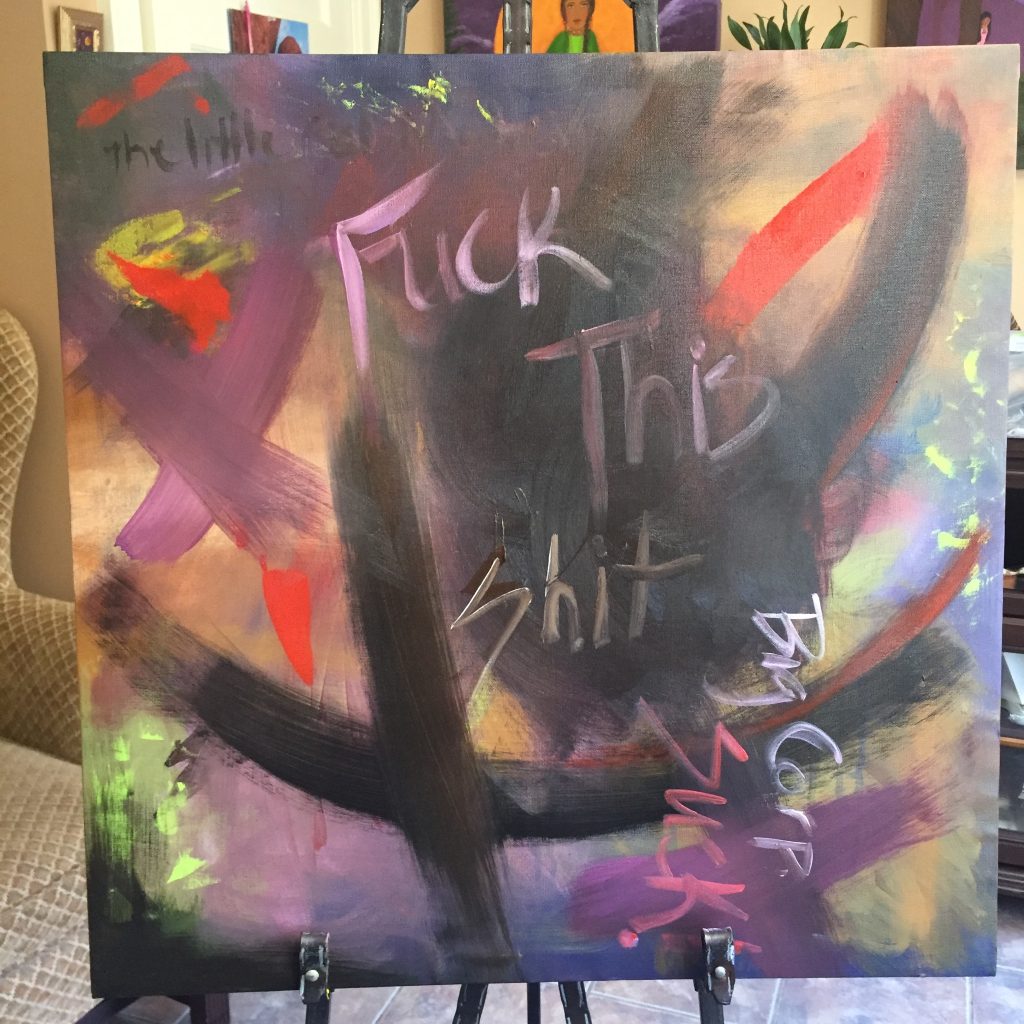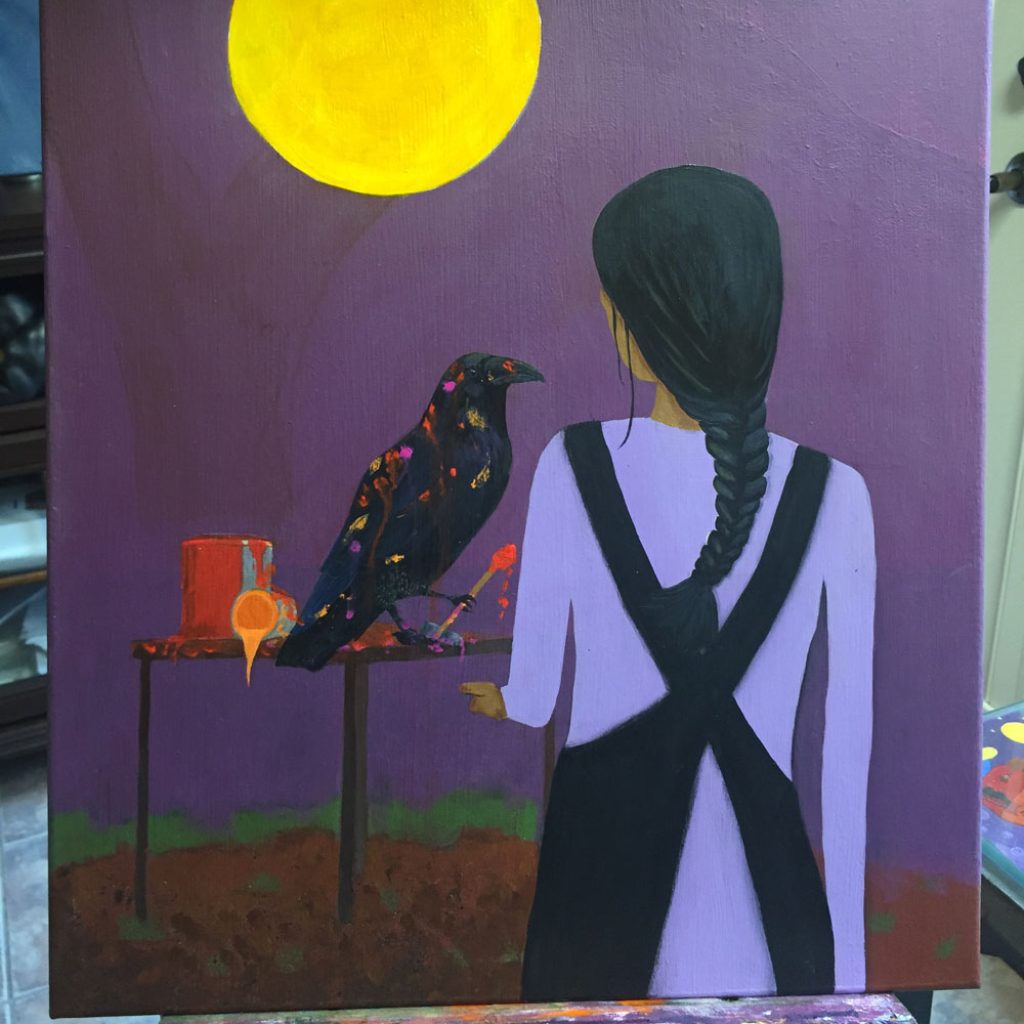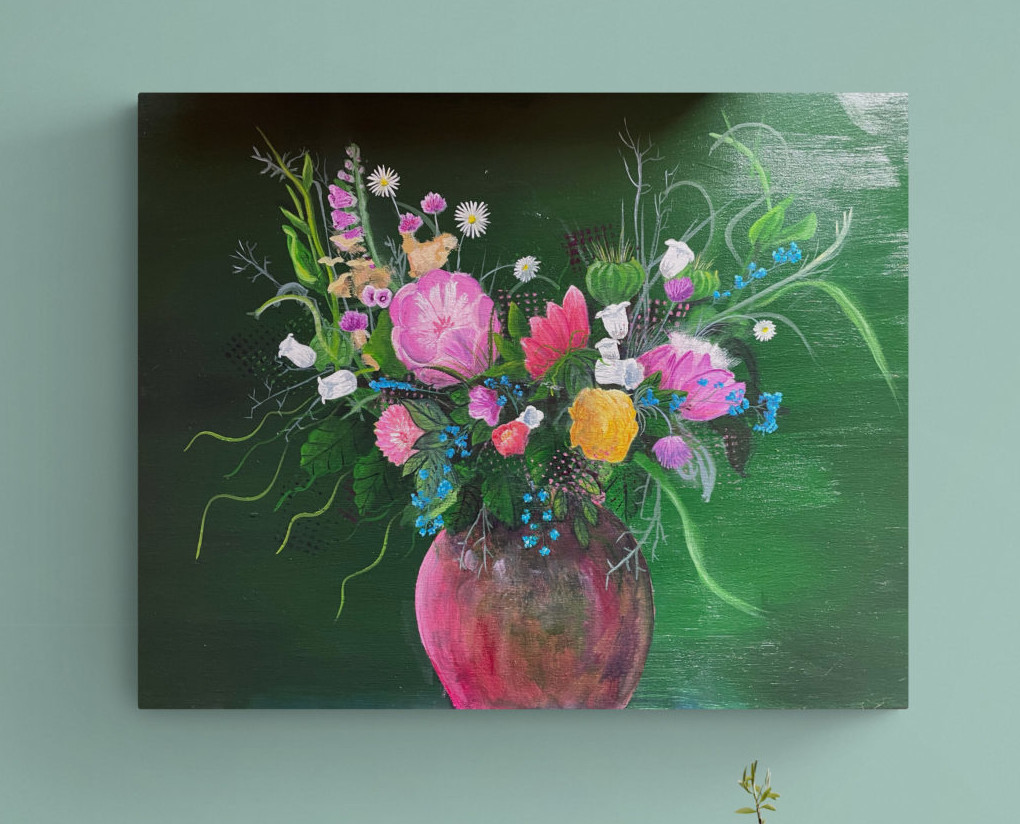Intuitive Painting Part 2 – Middle Mayhem
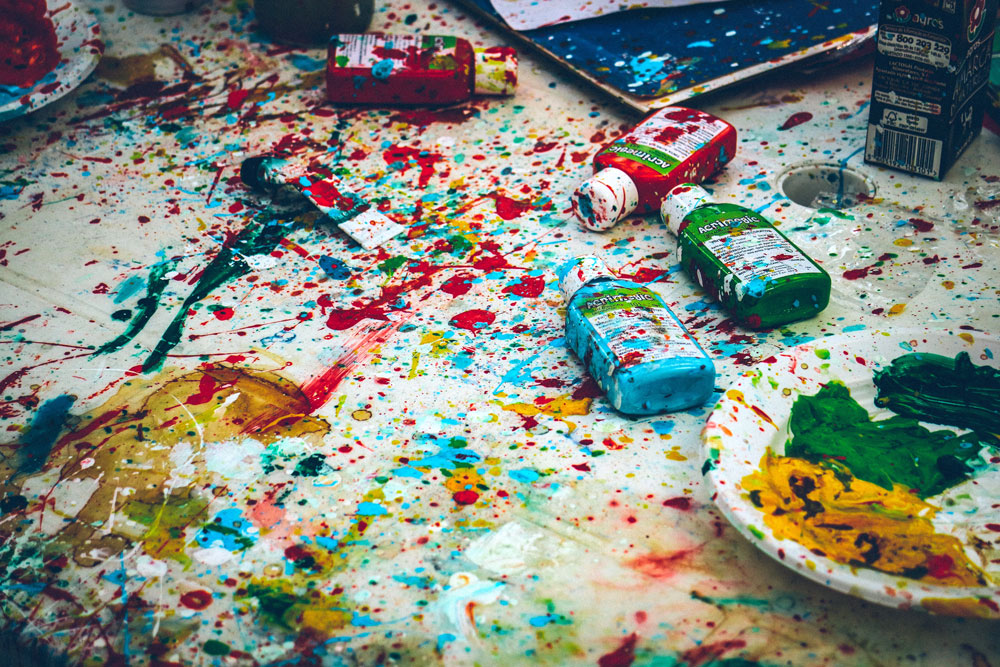
You don’t suck – it’s just the messy middle!
As a painter, did you know that the “messy middle” is a common occurrence? But what is the messy middle? As the name implies it is the stage you hit, typically in the middle of creating a painting, where it all seems to fall apart or you hit a wall and don’t know what to do next. I hadn’t known this was a “thing” when I experienced my first messy middle working on a painting called, of all things, The Helper, back in 2020. That painting was about to help me, by teaching me in a tough love kind of way, how to navigate the messy middle with a balance of patience, discernment and intuition.
According to my thumbnail sketch, the painting was to portray a mischievous raven helping a Kachina woman paint. It was meant to be a bit tongue in cheek because the raven was clearly getting more paint on itself than anywhere else. Things were going swimmingly well as I laid in the background and painted in some of the foreground elements, including the raven. The lovely feeling of flow, however, vanished shoftly after I painted in the Kachina. Something was off.
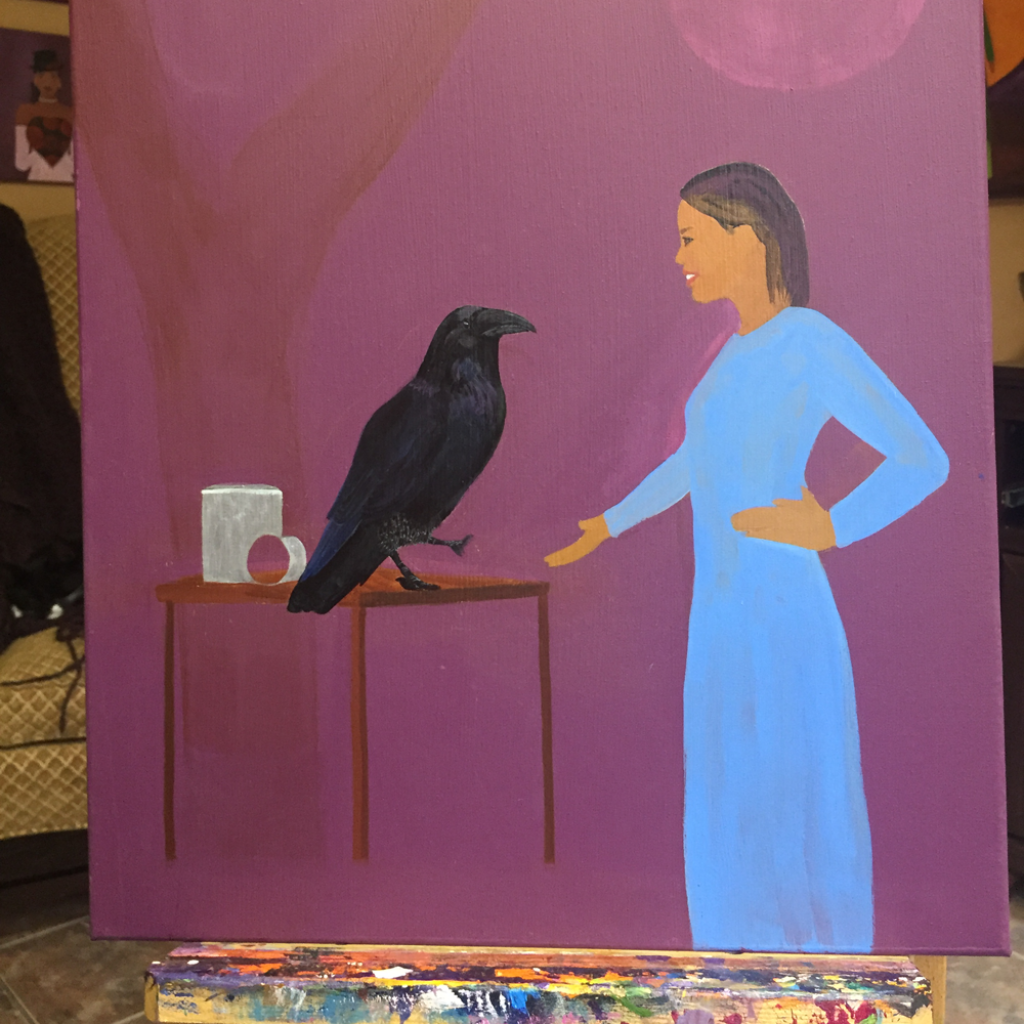
With a sinking feeling, I realized the perspective of the Kachina woman to the raven was out of whack. I tried fixing the problem, by painting over her and making her bigger. That didn’t help, so I repainted the height of the table the raven was standing on. That didn’t work either. I kept trying to fix it by repainting an area and then removing it when it didn’t work. While all this was going on, my inner mean girls were getting louder. “Your drawing skills suck. You’re not a real artist, a real artist would be able to fix this quickly. You should just give up before you totally embarrass yourself.” The harder I tried, the louder the voices got and the more frustrated and exasperated I became. My problem solving had sunk to desperation, rather than inspiration.
Step away and let it simmer.
Recognizing that I was only making things worse, I pushed the painting away. As I prepared to move the painting out of sight, I suddenly remembered something I learned from local pastel artist, Helen Hazen, many years ago in an interview. She told me she liked to prop her in-progress paintings in a visible location because each time she walked by it, she’d notice little things to fix or improve in the painting. Okay, I’ll try that I thought and rolled the painting to a place where I could see it as I went about my day.
I also used this time to review the painting and determine what I liked and didn’t like about the painting so far by asking myself:
- Do I like these colors
- What do I want to see more of?
- What do I want to reduce or tone down?
- What do I like or don’t?
Navigating our way through the messy middle requires patience and faith. Patience because the creative process doesn’t work on a human timeline. Some paintings need time to sit and marinate, to give our mind and intuition time to noodle the challenges of the painting in an indirect, soft focus type of way.
Although may feel as if little progress is being made, “simmering” is not sitting around doing nothing. It’s allowing our deductive reasoning and intuition to stew together to come up with solutions we may have not considered. When we give our paintings time to simmer, we allow the alchemy of the creative process to bring intuitive answers to us. And that requires patience.
Have a spare canvas to ramp up and cool down with
Another thing that helped me tremendously, was stumbling upon a tip from Nicholas Wilton. He suggested having a spare canvas to vent on. I did a variation of this by painting on a junk canvas before I worked on The Helper. I didn’t want to approach the canvas with fear and trepidation, so I started with the junk canvas first. On the junk canvas, I used colors that made me happy and I made big sweeping gestures, working quickly and spontaneously. When my energy felt light and bright, I resumed working on The Helper. Other times, when I lost my way, I used the junk canvas to paint my frustrations, pouncing my anger onto the surface and sometimes even writing “Fu%# This Shit” in big bold brush strokes” (see canvas below). It felt so good to have a place to let the angst out!
Let go of expectations to make room for intuition
In my early sketch, the raven and the Kachina woman faced each other but it just wasn’t working. Ultimately, I had to let that go. My friend, Ravi Tangri, a life coach and avid West Coast Swing dancer, likes to say that manifesting is a lot like dancing. “Sometimes you lead and sometimes you follow.” In struggling through The Helper, I learned the creative process works that way too. The Helper taught me to loosen the grip I had on the intended outcome, so intuition could lead me to a better place.
Eventually, I was inspired to move the Kachina woman towards the foreground with her back towards the viewer as she faced the raven. Typically it’s not a good idea to have a back to the viewer but when I painted it that way, it felt right. You can see the completed painting here: The Helper. This painting now resides in a collection in Northern New Hampshire.
Work on multiple paintings at once.
When the flow of one painting peeters out, move onto the next one, and rotate your way through three or four paintings at a time. By the time you’ve worked your way back to the original painting, the next action step is often suddenly clear and the flow begins anew. I didn’t learn this approach until shortly after I’d completed The Helper, but I’ve used it ever since. This approach works well for me, especially in the beginning and middle stages, because my energy begins to fizzle when I stick with one painting too long, which for me is somewhere between 30 – 45 minutes. Rotating between paintings keeps me fresher and helps me avoid becoming too vested in the progress of one painting.
Embrace the Messy Middle – It Means Your Artist
I’ve listened to a lot of art related podcasts over the last few years and have learned, with much relief and delight, that I’m not alone. The messy middle is a real thing. Successful, thriving artists encounter the messy middle on a routine basis. I’ve also gone through many more messy middles myself and successfully made my way through them. When you hit this stage, take heart! It doesn’t mean you suck, it just means you are an artist. And, with a little patience and faith, you will find your way through it too. In fact, I’ve come to think of the messy middle as similar to the chrysalis state of a butterfly – some things have to break down and become mush before they can transform into something beautiful.
Here’s the message from The Helper:
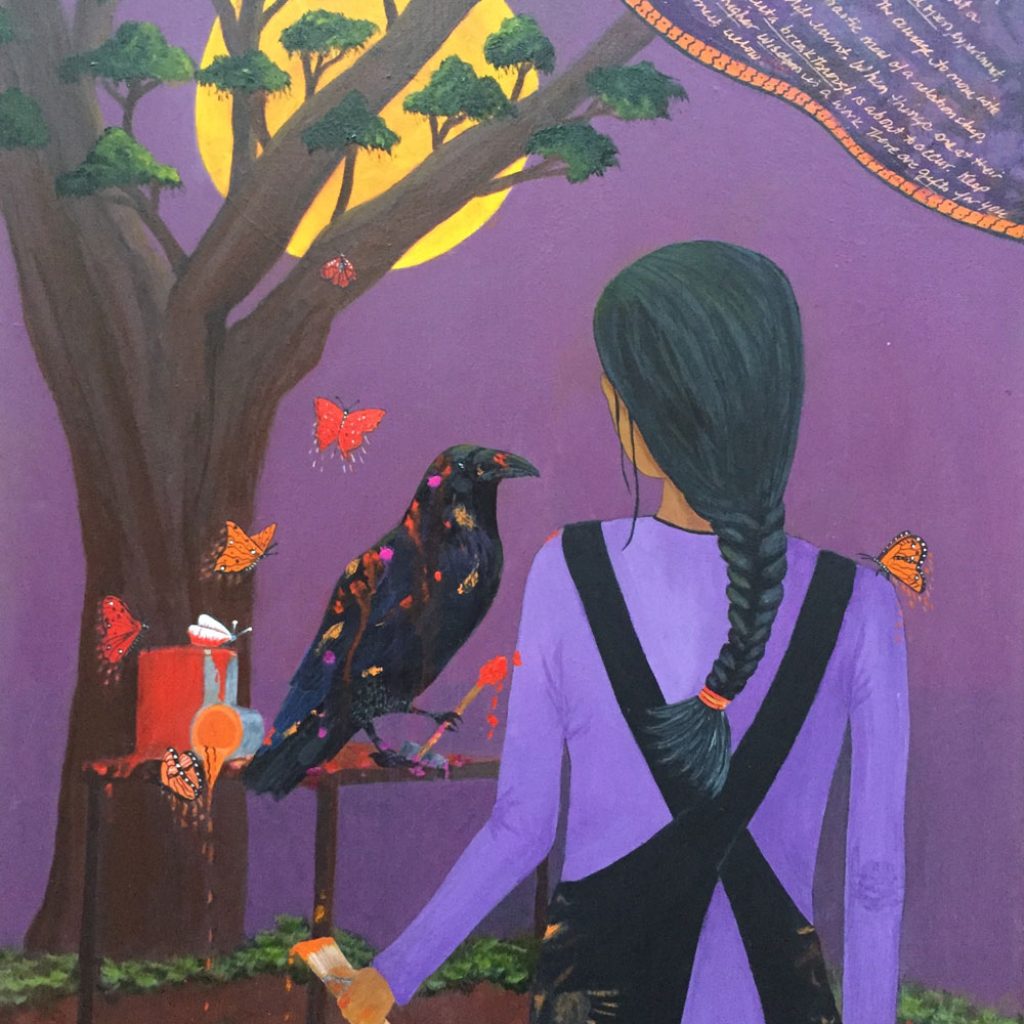
The Helper’s sacred message:
“Raven is stirring things up! We are invited to loosen our grip and adopt a playful spirit. Be open, experiment, and play. Muster the courage to move into and through the chaotic mess of a relationship, special project, or life event. When things are at their most jumbled, trust a breakthrough is about to occur. Keep moving forward. A higher wisdom is a work. There are gifts for you within the motley mess. Allow the gifts of chaos to emerge in all their glorious color.”
Stay tuned for Part 3 for the intuitive roadblocks to completing a painting.

